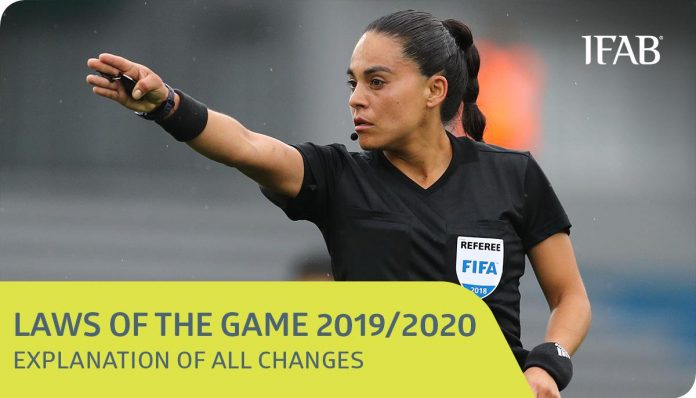The 133rd AGM of The International Football Association Board (The IFAB) held in Aberdeen, Scotland on 2 March 2019 approved a number of amendments to, and clarifications of, the Laws of the Game for 2019/20.
Off-side rule, Sri Lanka football referees & Sri Lanka Football
The Dialog Champions League 2018 match week ……..
Three changes were approved following 2 years of worldwide experiments;
- The introduction of yellow and red cards for misconduct by team officials.
- A player being substituted leaving the field at the nearest point on the boundary line.
- A goal kick and a free kick for the defending team in their own penalty area, the ball is in play as soon the kick is taken (it can be played before it leaves the penalty area).
Other changes include:
- Clearer wording for ‘handball’.
- Attacking team players must be at least 1m away from a defensive ‘wall’.
- The goalkeeper only has to have one foot on the goal line at a penalty kick.
- New dropped ball procedure.
Substitutes – Law 3
- A player who is being substituted must leave the field by the nearest point on the touchline/goal line (unless the referee indicates the player can leave quickly/immediately at the halfway line or a different point because of safety, injury etc.)
The substitution protocol has been changed in order to avoid time wasting tactics of a team. Often a player on the far side is substituted to take maximum advantage as the player must exit the area of play from the centre line where the fourth official is positioned.
The new change says that players who are being taken off and replaced must now leave the pitch by the nearest point on the touchline.
The player must go immediately to the technical area or dressing room to avoid problems with substitutes, spectators, or the match officials. A player who infringes the spirit of this Law should be sanctioned for unsporting behaviour i.e. delaying the restart of play.
So players will now have to think twice about how they exit the pitch and, not only that, they must also make their way straight to the technical area or dressing room after being subbed, or risk being sanctioned for unsporting behaviour.
Dropped Ball – Law 8 & 9
- If play is stopped inside the penalty area, the ball will be dropped for the goalkeeper
- If play is stopped outside the penalty area, the ball will be dropped for one player of the team that last touched the ball at the point of the last touch
- In all cases, all the other players (of both teams) must be at least 4m (4.5yds) away
- If the ball touches the referee (or another match official) and goes into the goal, team possession changes or a promising attack starts, a dropped ball is awarded
The current dropped ball procedure often leads to a ‘manufactured’ restart which is ‘exploited’ unfairly (e.g. kicking the ball out for a throw-in deep in the opponents’ half) or an aggressive confrontation.
Returning the ball to the team that last played it restores what was ‘lost’ when play was stopped, except in the penalty area where it is simpler to return the ball to the goalkeeper. To prevent that team gaining an unfair advantage, all players of both teams, except the player receiving the ball, must be at least 4m (4.5 yds) away.
It can be very unfair if a team gains an advantage or scores a goal because the ball has hit a match official, especially the referee.
Handball – Law 12
- Deliberate handball remains an offence
- The following ‘handball’ situations, even if accidental, will be a free kick:
1. the ball goes into the goal after touching an attacking player’s hand/arm
2. a player gains control/possession of the ball after it has touches their hand/arm and then scores, or creates a goal-scoring opportunity
3. the ball touches a player’s hand/arm which has made their body unnaturally bigger
4. the ball touches a player’s hand/arm when it is above their shoulder (unless the player has deliberately played the ball which then touches their hand/arm)
- The following will not usually be a free kick, unless they are one of the above situations:
1. the ball touches a player’s hand/arm directly from their own head/body/foot or
the head/body/foot of another player who is close/near
2. the ball touches a player’s hand/arm which is close to their body and has not
made their body unnaturally bigger
3. if a player is falling and the ball touches their hand/arm when it is between their
body and the ground to support the body (but not extended to make the body
bigger)
4. if the goalkeeper attempts to ‘clear’ (release into play) a throw-in or deliberate
kick from a team-mate but the ‘clearance’ fails, the goalkeeper can then handle
the ball
The IFAB has attempted to provide more clarity on the handball offence for occasions when the offence is deemed to be ‘non-deliberate’.
Essentially, the changes will mean that there will be no goal in cases where the ball accidentally strikes a player’s hand before crossing over the line. Football does not accept a goal being scored by a hand/arm even if accidental.
Similarly, if a player has accidentally handled the ball and created an advantage or subsequently scores, they will be penalised with a free kick.
Free Kicks – Law 13
- When there is a ‘wall’ of three or more defenders, the attackers are not allowed within 1m (1 yd) of the wall; an attacker less than 1m (1yd) from the ‘wall’ when the kick is taken will be penalised with an indirect free kick
- When the defending team takes a free kick in their own penalty area, the ball is in play once the kick is taken; it does not have to leave the penalty area before it can be played
The IFAB has approved a rule change which prohibits attacking players – i.e those from the team attacking from the free kick being in the wall. Specifically, when there is a wall of three or more players, attackers are not allowed within one metre of it.
Any attacking player found to be less than one metre from the wall when a free kick is taken will be penalised and the other team will be rewarded with an indirect free kick.
The idea behind the change is to avoid time wasting and disturbances between players that may result in physical altercations.
The IFAB said; “There is no legitimate tactical justification for attackers to be in the ‘wall’ and their presence is against the ‘spirit of the game’ and often damages the image of the game.”
Also a free kick awarded to the defending team in their own penalty area will be live as soon as the kick has been taken and does not have to leave the penalty area.
Penalty Kick – Law 14
- The team’s penalty taker can have (quick) treatment/assessment and then take the kick
- The goalkeeper must not be touching the goalposts/crossbar/nets; they must not be moving
- The goalkeeper must have at least part of one foot on/in line with the goal line when the kick is taken; cannot stand behind the line
The issue of penalty kicks has cropped up a few times in recent years and the trend has been towards reducing the freedom of the goalkeeper.
That hasn’t changed with the latest update to the rules, which dictate that the shot-stopper must not be moving or touching the goalposts when a penalty is being taken. The new rule changes also say that the goalkeeper must have at least part of one foot on or in line with the goal-line.
Allowing the goalkeeper to have only one foot touching the goal line (or, if jumping, in line with the goal line) when the penalty kick is taken is a more practical approach as it is easier to identify if both feet are not on the line.
Goalkeepers are not permitted to stand in front of or behind the line. As the kicker can ‘stutter’ in the run, it is reasonable that the goalkeeper can take one step in anticipation of the kick.
As well as those points, the penalty taker will now be permitted to receive a quick treatment if necessary before taking the kick.
Team Officials – Law 5
- A team official guilty of misconduct will be shown a YC (caution) or RC (sending-off); if the offender cannot be identified, the senior coach who is in the technical area at the time will receive the YC/RC.
In order to clamp down on difficult behaviour from coaches who don’t see eye to eye with the referee or their opposite number, officials will be able to show them yellow or red cards, in the same way they do with players.
If, in the event of a touchline melee for example, the offending individual cannot be identified for punishment, the senior coach who is in the technical area will be the default recipient.
Other Minor Changes Include,
Goal Kick – Law 16
- The ball is in play once the kick is taken; it can be played before leaving the penalty area
The experiment that at a goal kick the ball is in play once it is kicked, and does not have to leave the penalty area, has created a faster and more dynamic/constructive restart to the game. It has reduced the time ‘lost/wasted’ including stopping the tactic of ‘wasting’ time when a defender deliberately plays the ball before it leaves the penalty area knowing that all that will happen is the goal kick will be retaken. Opponents must remain outside the penalty area until the ball is in play.
Goal Celebrations – Law 12
- A Yellow Card for an ‘illegal’ celebration (e.g. removing the shirt) remains even if the goal is disallowed.
Kick-off – Law 8
- The team that wins the toss can now choose to take the kick-off or which goal to attack (previously they only had the choice of which goal to attack)
Medical Breaks – Law 7
- Difference between ‘cooling’ breaks (90 secs – 3 mins) and ‘drinks’ breaks (max 1 min).
In the interests of player safety, competition rules may allow, in certain weather conditions (e.g. high humidity and temperatures), ‘cooling’ breaks (from ninety seconds to three minutes) to allow the body’s temperature to fall; they are different from ‘drinks’ breaks (maximum one minute) which are for rehydration.
Players’ Equipment – Law 4
- Multi-coloured/patterned undershirts are allowed if they are the same as the sleeve of the main shirt.
Quick Free Kick and YC/RC – Law 12
- If the referee is about to issue a YC/RC but the non-offending team takes the free kick quickly and creates a goal-scoring opportunity, the referee can delay the YC/RC until the next stoppage if the offending team was not distracted by the referee
IFAB formed in 1886, made up of the four British associations (the English FA, Scotland FA, FA Wales and Ireland FA) and FIFA is the only organisation that has the authority to review and change the rules governing the game of football. The four British associations have one vote each and FIFA – representing the remaining 207 national associations – has four votes.
In its mission, the IFAB declares; “We listen to the football community, with the goal to improve and develop the game for players, match officials and fans while protecting and strengthening the spirit and simplicity of football.”
All changes come into force on 1st June 2019. Competitions starting before that date may apply the changes from the start of their competition, at an agreed point during the competition (e.g. after the mid-season break) or may delay them until no later than the start of the next competition.
>>click here for more Football news<<























